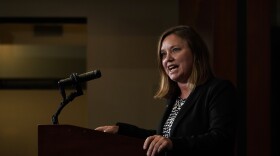WESA's local, independent journalism is only possible because of financial support from readers like you. Please support WESA by making a donation during our fall fundraising campaign.
Construction crews on Thursday will begin installing traffic calming measures on Schenley Avenue and North Mathilda Street in Garfield. It’s one of many similar projects popping up around the city aimed at slowing down cars, trucks and buses and eliminating traffic deaths.
Crews are putting in five speed humps along the street as well two speed tables at intersections where buses run. Speed tables are flatter and wider than speed humps and make it easier for people to get on and off of buses. The city selected these streets in Garfield after they found that the majority of drivers through the residential area exceeded the speed limit.
The city’s Department of Mobility and Infrastructure’s traffic calming program is a part of the city’s commitment to “Vision Zero” — a traffic safety plan with a goal of zero traffic deaths. Last year, 23 people died on the streets of Pittsburgh. One out of every four of those crashes involved a pedestrian, according to Pennsylvania Department of Transportation data.
So far, DOMI has completed 68 traffic calming projects on a number of residential streets throughout Pittsburgh — from Tripoli Street on the North Side to Greenfield Ave. in Greenfield. Another 16 projects are in the works.
Anyone can request a traffic calming project on DOMI’s website. For a street to be eligible, it must be a local road owned by the city.
Construction in Garfield is expected to last two days, during which the road will be down to one lane with flaggers directing traffic.
Support WESA
WESA keeps you informed. And an informed community is more likely to vote, take care of local institutions, and work together to help others. We highlight solutions to our community’s challenges and clear a path for our neighbors to thrive.
The best local news has a positive impact on the people who use it. That’s what we do here at WESA. We aim to help our community through trusted news. Your gift supports the information everyone in Pittsburgh needs. One story can change someone’s life. You can make that story possible.
Your contribution protects a free press here in Pittsburgh. Please make sure our region can depend on news that’s based on facts.
Please make a one-time gift or consider increasing your monthly support by $2 or $3.






